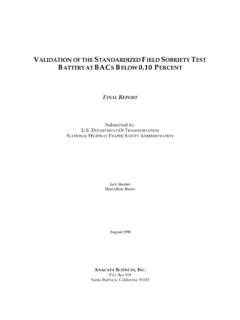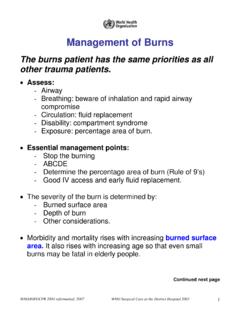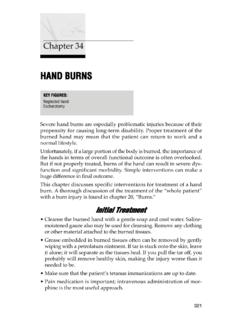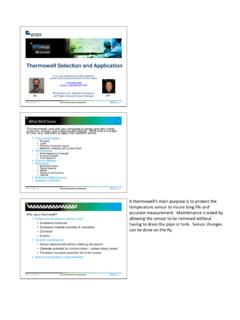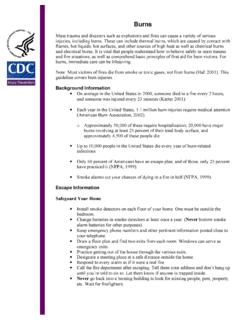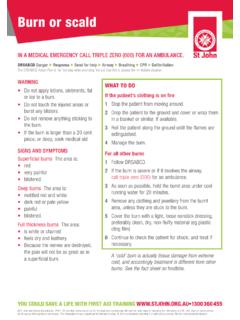Transcription of A Florida Validation Study of the Standardized …
1 Department People Saving People of Transportation National Highway Traffic Safety Administration A Florida Validation Study of the Standardized Field Sobriety Test ( ). Battery Marcelline Burns, Southern California Research Institute Los Angeles, California Teresa Dioquino, Sergeant Pinellas County Sheriff s Office Largo, Florida This research project was prepared for the State Safety Office, Department of Transportation, State of Florida in cooperation with the National Highway Traffic Safety Administration, Department of Transportation and/or Federal Highway (under project number AL-97-05-14-01). The conclusions and opinions expressed in these reports are those of the subgrantee and do not necessarily represent those of the State of Florida , Department of Transportation, State Safety Office, the Department of Transportation or any other agency of the State or Federal Government. PROJECT STAFF. Institute of Police Technology and Management University of North Florida Russell Arend Contractor Director Pinellas County Sheriff s Office Teresa R.
2 Dioquino Project Manager Sergeant Southern California Research Institute Marcelline Burns, Investigator Graphics Dary Fiorentino, Consultant Senior Data Theresa Brown Processor Shana Nguyen Data Processor Cindy Seymour Data Processor TABLE OF CONTENTS. I. INTRODUCTION. II. Study BACKGROUND AND RATIONALE. III. Study DESIGN. IV. METHOD. A. SFST Standardization B. Data Integrity C. Data Completeness D. Data Analysis V. RESULTS. A. Total Sample and Measured BACs 1. Arrested Drivers 2. Released Drivers 3. Drivers with Suspended/Revoked Licenses 4. Refusals B. Officers Decisions 1. Officers Correct and Incorrect Decisions for Drivers with Measured BACs 2. Officers Decisions When Other Tests Were Used in Addition to the SFSTs C. Field Sobriety Tests 1. Horizontal Gaze Nystagmus (HGN). 2. Walk-and-Turn Test (WAT). 3. One-Leg Stand (OLS). D. Officers E. Observers F. Drivers 1. Gender 2. Ages 3. Ethnicity 4. Employment Status 5.
3 Vehicles G. Conditions and Circumstances of Stops 1. Day of Week and Time of Day 2. Weather, Roadway and Test-surface Conditions 3. Reason for Stop H. Reasons for Vehicle Stop, by BAC. VI. SUMMARY AND DISCUSSION. REFERENCES. APPENDICES. I Demographics of Pinellas County, Florida The Pinellas County Sheriff s Office II Florida Statute, Driving Under the Influence III Study Forms IV Case Logs V Drugs Reported by Drivers VI "Iguana Driving". TABLE OF TABLES. TABLE. Participating Pinellas County Sheriff Deputies Ranked by Years of Law Enforcement 1. Experience 2 Participating Pinellas County Sheriff Deputies Ranked by Estimated Number of DUI. Arrests 3 Disposition of 379 Cases 4 Mean SFST Scores, BACs, and Ages by Case Disposition 5 Observers 6 Driver Ages 7 Driver Ethnicity 8 Driver Employment Status 9 Reasons for Stops, by BAC Groups TABLE OF FIGURES. FIGURE. 1 Decision Matrix 2 Study Hypothesis 3 Case Disposition 4 Measured Positive BACs 5 Decision Matrix, 256 Cases with BAC Measurements 6 Officer Decisions (N = 256).
4 7 Decision Matrix, 41 Cases with Measured BAC and Use of Other Tests 8 Officer Decisions with Tests in Addition to SFSTs (N = 41). 9 BAC Distribution-One Leg Stand 10 Officer Experience in Law Enforcement 11 Officers DUI Arrests 12 Driver Ages I. INTRODUCTION. During the years 1975 - 1981, a battery of field sobriety tests was developed under funding by the National Highway Traffic Safety Administration (NHTSA), Department of Transportation (Burns and Moskowitz, 1977; Tharp, Burns, and Moskowitz, 1981). The tests include Walk-and-Turn (WAT), One-Leg Stand (OLS), and Horizontal Gaze Nystagmus (HGN). NHTSA subsequently developed a training curriculum for the three-test battery, and initiated training programs nationwide. Traffic officers in all 50 states now have been trained to administer the Standardized Field Sobriety Tests (SFSTs) to individuals suspected of impaired driving and to score their performance of the tests.
5 At the time the SFSTs were developed, the statutory blood alcohol concentration (BAC). for driving was throughout the United States. The limit now has been lowered in a number of states to for the general driving population. Zero tolerance is in effect in some jurisdictions for drivers under age 21, and commercial drivers risk losing their licenses at a BAC of It is likely that additional states will enact stricter statutory limits for driving. In light of these changes, a re-examination of the battery was undertaken by McKnight et al. (1995). They reported that the test battery is valid for detection of low BACs and that no other measures or observations offer greater validity for BACs of and higher. The three tests have been incorporated into Drug Influence Evaluations (DIEs) which are conducted by certified Drug Recognition Experts (DREs) whenever an individual is suspected of being drug-impaired. As part of a DRE evaluation, the SFSTs provide important evidence of drug impairment and contribute to the DRE's three-part opinion: Is the individual impaired by a drug or drugs?
6 If yes, is the impairment drug-related? If yes, what category or categories of drug account for the impairment? A Study was conducted in Colorado to examine the validity of the SFSTs when used by experienced officers in the field (Burns and Anderson, 1995). The design of the Study insured that roadside testing was limited to the three-test battery, and that officers'. decisions were not influenced either by the driver's performance of other behavioral tests or by measurement of BAC with a preliminary breath tester (PBT). The obtained data demonstrated that more than 90% of the officers' decisions to arrest drivers were confirmed by analysis of breath and blood specimens. A recently-reported NHTSA-funded Study was conducted by Anacapa Sciences, Inc. in collaboration with the San Diego Police Department to examine the validity of the SFSTs for both and (Stuster and Burns, 1997). Officers' estimates of whether a driver's BAC was above or below or were found to be more than 90%.
7 Correct. The Colorado and California studies provide relevant and current field data. The validity of the tests when they are administered in the context of drug evaluations was examined in a retrospective analysis of the records of the Phoenix (DRE Unit (Adler and Burns, 1994). It was found that a suspect's performance of the tests provides valid cues of drug impairment. The Study reported here was conducted in collaboration with the Pinellas County Sheriff's Office (PCSO) and expands the examination of the SFSTs to the State of Florida . An overview of PCSO and the demographics for Pinellas County can be found in Appendix I. II. Study BACKGROUND AND RATIONALE. During the early years of SFST use by law enforcement, legal challenges were relatively infrequent. For more than a decade now, however, defense counsel in many jurisdictions has sought to prevent the admission of testimony about a defendant's performance of the three tests.)
8 The objections, which continue to be persistent and vigorous in 1997, typically focus on test validity and reliability as demonstrated in the original laboratory research. It is entirely appropriate to inquire whether that early research to identify a best set of sobriety tests was conducted with scientific rigor. Beyond that inquiry, however, the data, which were obtained in a laboratory setting and now are more than twenty years old, are of little interest. Certainly, they are only marginally relevant to current roadside use of the tests. The question which begs to be addressed in 1997 is whether the tests are valid and reliable indices of the presence of alcohol when they are used at roadside under present day traffic and law enforcement conditions. Experience and confidence have a direct bearing on an officer's skill with roadside tests. In this regard, note that the officers who participated in the early SCRI studies had been only recently and briefly (4 hrs) trained to administer the test battery.
9 There had been no time for them to use the tests in the field where they might have developed confidence in decisions based on them. Nonetheless, their decisions were 76% correct in the first Study and 81% correct in the second Study . At this point in time, many traffic officers have had ten or more years' experience with the test battery and many report that they confidently rely on them. Since it seems unlikely in the extreme that they would continue to rely on tests which repeatedly lead to decision errors, it is a reasonable assumption that more often than not their roadside decisions to arrest are supported by measured BACs. Whether their decisions to release are correct is largely unknown since the released driver's BAC generally is not measured. Traffic officers are charged with the detection and arrest of impaired drivers. Although their roadside duties are central to roadway safety, recognition of alcohol-impaired drivers can be difficult and is, therefore, subject to error.
10 If officers are to effectively meet this particular enforcement responsibility, they need to augment their general observations of suspects with sensitive, accurate sobriety tests. The tests not only aid in the removal of dangerously impaired drivers from the roadway, they also protect the driver who is not alcohol or drug impaired from being improperly detained. Thus, rigorous examinations of the SFSTs are important to traffic safety. Whether an officer's decision about a suspected DUI driver is correct or incorrect is determined by measurement of BAC and the jurisdiction's statute. The Florida statute (Appendix II) states that a person is guilty of driving under the influence of alcohol if he1. has a blood-alcohol level of or more grams of alcohol per 100 milliliters of blood or the equivalent measure a breath-alcohol level of or more grams of alcohol per 210. liters of breath . In commonly-used nomenclature, a driver in the State of Florida is subject to arrest if he is operating a motor vehicle when his BAC is or higher.
